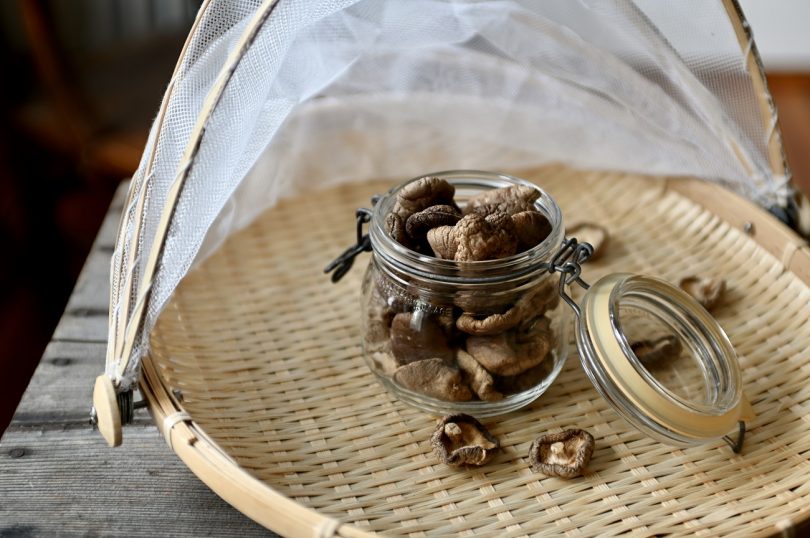If you want to keep your shiitake mushrooms for a long time, drying them is a great way. You can dry your excess shiitake mushrooms in several easy ways. Just choose the method that is convenient for your particular situation.
READ ALSO: How to Dehydrate Food Successfully: A Beginner’s Guide
Easy Methods for Drying Shiitake Mushrooms
The following are some tips to keep in mind when drying shiitake mushrooms.
- First, you need to prepare the mushrooms for drying. Don’t waterlog them. Excess moisture will make the drying process too tedious. If the mushrooms are dirty, just wipe them off using a damp cloth or paintbrush, instead of soaking in water.
- Use the lowest heat setting possible for drying shiitake mushrooms. High heat settings can destroy the mushrooms’ beneficial compounds. Use lower settings instead of merely roasting them.
- The mushrooms must be dry to the point that they’ll easily snap and break apart, similar to a dry cracker. If they bend (instead of snapping) and are still moist, just keep on drying. Otherwise, the mushrooms may develop mold or they may rot.
- If you are allergic to mushroom spores, the spores may disperse through heating and moving. Thus, it may not be a good idea to proceed with your drying project, and you may be better off just buying dried mushrooms.
READ ALSO: How to Dehydrate Mushrooms Properly
Drying shiitake mushrooms with a dehydrator
Drying shiitake mushrooms using a food dehydrator is easy, and it doesn’t need babysitting. You can dry as many mushrooms as you need to, depending on the number of racks you have. The more mushrooms you need to dry at the same time, the longer the drying time you may need.
- Cut the shiitake mushrooms to allow them to dry faster. You can slice them into ½” pieces or right down the middle, depending on the shape.
- Arrange the mushrooms on the racks, then assemble the dehydrator.
- Lay the pieces down. Avoid packing tightly that the pieces are touching one another.
- Use a low heat setting (150F/60C or less). While it may take a long time to finish drying (8 to 10 hours), there is little risk of damaging the mushrooms.
Check the mushrooms every few hours. Remove from heat once they are cracker-dry. Note that some of the mushrooms may dry faster than the others. Let them cool.
READ ALSO: A Guide for Beginners: How to Dehydrate Food with a Dehydrator
Drying shiitake mushrooms in an oven
If you find the cost of a dehydrator prohibitive, you can use your oven instead. Basically, the idea is the same, which is to apply heat to eliminate moisture. Just don’t bake the mushrooms under too much heat or you’ll burn off the healthy compounds or char the mushrooms.
- Preheat the oven to 150F/60C.
- Cut the mushrooms into ½” pieces or right down the middle, depending on the shape.
- Arrange the pieces on a baking sheet or pan without oil. Avoid packing them tightly, making sure the pieces don’t touch one another.
- Put the baking sheets in the oven, then allow to cook for an hour. Leave the oven door open a bit to allow moisture to escape. After an hour, pull out the mushrooms. Flip the pieces over, then leave to cook for an hour more. Continue this step until all the mushrooms are completely dry.
Compared to using a food dehydrator, using an oven requires a bit more babysitting. However, this method is cheaper and allows you to dry bigger batches simultaneously. Just remember that they are in the oven, so you need to check frequently.
Sun-drying
The sun offers an easy and free way to dry your shiitake mushrooms. After all, you don’t need electricity. While it may take a longer time to dry shiitake mushrooms this way, this is the best natural drying method to use if you want to preserve the flavor and potency well.
When sun-drying, you need to make sure to have the appropriate environment. The area must be non-humid and sunny. Otherwise, your mushrooms may just rot, instead of drying up.
- Choose a spot with a lot of Sun. It can be a windowsill or a flat roof. Make sure the mushrooms are safe from animals, insects, and moisture. There must also be some airflow. Don’t choose a closed-off, stagnant room.
- Cut the mushrooms into ½” pieces or right down the middle, depending on the shape.
- Lay the mushrooms down in the drying area. Avoid stacking them one on top of another.
- Allow the sun to do its magic. Check several times during the day to see how the mushrooms are doing. Complete drying may be achieved in one or two days.
Depending on where you live, there’s a possibility that your shiitake mushrooms will not fully dry up. You’ll know after a day or two when you see that the mushrooms may be somewhat dry, but still a bit flexible or possess a rubbery feel.
When this happens, finish the job using a dehydrator or oven. Check frequently as it will not take too long to completely dry the mushrooms at this point.
Using a box fan
Like heat, moving air can also help get rid of moisture. You can pair this method with sun-drying.
- Set up everything as you would when using the sun-drying method. Place a box fan near the mushrooms.
- Use the fan’s highest setting as near the mushrooms as possible without blowing the mushrooms away.
- Check often throughout the day to gauge the progress of the drying process.
Like sun-drying, this method may not make your mushrooms completely dry. You may need to finish the job by heating.
Storing Dried Shiitake Mushrooms
After the drying process, store the shiitake mushrooms in airtight containers. Keep the containers in a dark, cool place, and away from direct sunlight. Likewise, never leave the dried mushrooms in the open, or anywhere moist or wet. This way, you can preserve the mushrooms for as long as nine months.
You may be asking, “Which drying method is best to use?” Each method discussed above has its own set of advantages. The quick answer is: using a food dehydrator is the most recommended unless you intend to dry a massive amount of mushrooms in one go!
Image: gourmetvegetariankitchen.com





